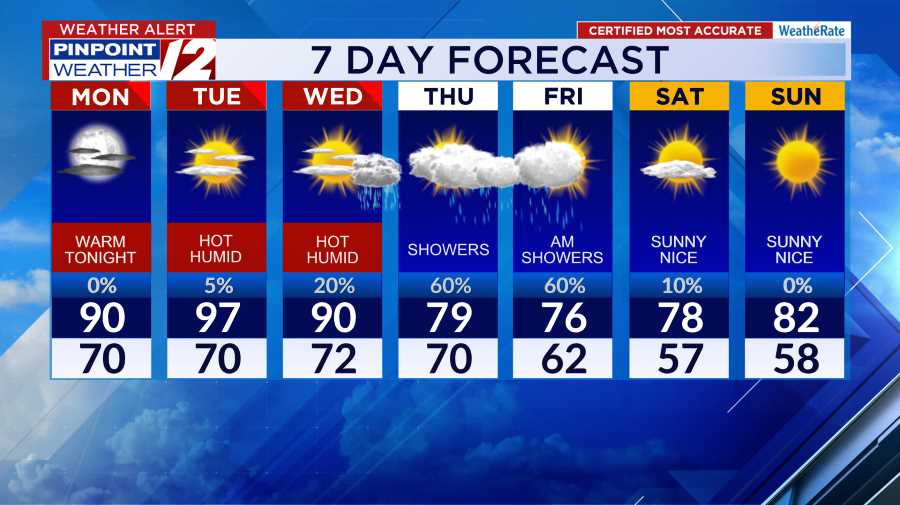EAST PROVIDENCE, R.I. (WPRI) – The Narragansett Bay Commission has received a $269 million federal loan to help fund one of the largest infrastructure projects in Rhode Island history, and officials say it could help hold down soaring sewer rates for customers in Greater Providence.
The quasi-public agency on Friday celebrated the low-interest loan from the U.S. Environmental Protection Agency, joining labor groups, elected officials and EPA leaders at the Bucklin Point Waster Treatment Facility in East Providence. The money will go toward the so-called Combined Sewer Overflow (CSO) project, which has been underway for decades and will likely end up costing $1.5 billion to complete.
“The impact of the cost of this project is felt by our ratepayers,” said Vincent Mesolella, the commission’s chairman. Borrowing the money in the private bond market at a higher interest rate would have cost ratepayers an extra $100 million in interest and fees, he said.
The Water Infrastructure Finance and Innovation Act (WIFIA) loan — the largest of its kind ever made in New England — carries an interest rate of 1.8%, and will go toward paying for a $550 million tunnel that will be constructed about 300 feet beneath Central Falls, Pawtucket and Providence.
The tunnel, which will capture sewer overflows when it rains to avoid stormwater pollution, is part of the $770 million Phase III of the federally mandated CSO project, which is expected to be finished by 2041.
“This is the largest public project in Rhode Island, and no one can see it,” quipped U.S. Sen. Jack Reed, who attended the event and has helped steer funding to the WIFIA loan program as a member of the Senate Appropriations Committee.
Phase III is the last part of a project that’s been going on for decades, ever since the EPA came down on Rhode Island in the 1990s for discharging wastewater into Narragansett Bay and mandated the problem be fixed.
The Narragansett Bay Commission entered into an agreement with the R.I. Department of Environmental Management in 1992 to create the CSO project, and four years later came up with a three-phase plan with the goal of reducing combined sewer overflow by 98% and reducing shellfish bed closures by 80%.
Fast forward more than two decades and DEM Director Janet Coit said the effects are noticeable.
“We’ve seen recreation come back to the bay – fishing, kayaking,” she said. “We’ve reopened parts of the bay to shellfishing where it’s been 70 years since these areas have been opened.”
But the work – which the quasi-public agency is required to do under the Clean Water Act — has come with a huge cost that could ultimately result in soaring sewer rates for some of Rhode Island’s poorest communities.
Target 12 earlier this year reported the average household’s sewer bill could climb 23% to help pay for the third phase of the project, from $480 a year in 2016 to $588 in 2025. Commission officials expect the $100 million in savings from the EPA loan could help offset those increases, but couldn’t say specifically how much.
General Treasurer Seth Magaziner, who has been outspoken about how much the project could cost ratepayers over time, called the loan a step in the right direction. But he said more must be done to prevent ratepayers from going broke paying their sewer bills.
“The EPA loan is helpful and definitely will make rates more affordable for a lot of people,” he said. “But we’re going to continue to meet with the commission to look for ways to make rates more affordable.”
The EPA defines sewer bills as unaffordable if they exceed 2% of household income, and by that metric the commission estimated sewer costs will be unaffordable for one in three households in 2025, including a majority of households in Central Falls. In Providence’s poorest neighborhood, the cost will be 4.4% of median household income.
The treasurer and commission officials have been meeting regularly in recent months to discuss possible options to fix that problem. The commission has already pushed off the Phase III completion date to help spread out the costs, and repayments of the EPA loan don’t need to start until five years after the project is completed, which could also help.
But Mesolella agreed more needs to be done, and said some ideas have included selling energy generated by the commission’s wind turbines. The proceeds, he said, could go toward offsetting costs for low-income ratepayers.
Another idea that has been floated is asking people outside the commission’s service network to chip in on the cost of a project, the argument being that it is benefiting a large swath of the Ocean State.
Narragansett Bay, Mesolella points out, is an amenity to several other coastline communities that are benefiting from the reduction in pollution being paid for by his ratepayers.
The commission in the past has advocated for the General Assembly to pass a general obligation bond that would ask all Rhode Islanders to help with the costs. That’s something Mesolella said he’d support again in the future.
Magaziner, who’s in charge of keeping track of the state’s overall debt capacity, said he agrees that most Rhode Islanders are benefiting from the CSO project.
“The counterargument is that other communities have their own sewer systems that they maintain, so they’re doing their part,” Magaziner said. “But I tend to be more progressive in my views on issues like this and I think the burden of cleaning the Bay should not fall disproportionately on poorer communities. It’s appropriate for people who can pay a little more to do so for our environment, so we’ll see.”
Click the arrows to scroll through a timeline of the CSO project.
Eli Sherman (esherman@wpri.com) is a Target 12 investigative reporter for 12 News. Connect with him on Twitter and on Facebook.
Ted Nesi contributed to this report.





















